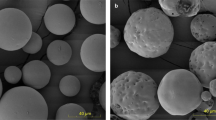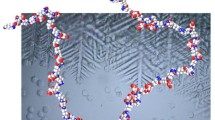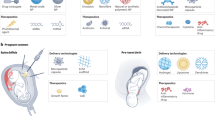Abstract
We have developed methods for controlling the release of antibodies (Ab) from biocompatible polymers. Human Ab, human Ab fragments, and mouse monoclonal antibody (mAb) directed against human chorionic gonadotropin (anti-hCG) were incorporated into matrices of poly(ethylene-co-vinyl acetate), which is stable in biological environments. Human Ab and bovine γ-globulin were also incorporated in biodegradable matrices of a polyanhydride copolymer composed of a stearic acid dimer and sebacic acid. Abs were slowly released from all the polymeric carriers during 30 days of continuous immersion in buffered saline. The ability of anti-hCG to bind antigen was retained following release from EVAc matrices. Only minor Ab aggregation was observed following release from either polymer. Polymeric delivery systems, similar to those described here, may become an important element in the delivery of mAbs to humans for immunoprotection against infectious diseases or the delivery of mAb-conjugates for immunotherapy against cancer.
This is a preview of subscription content, access via your institution
Access options
Subscribe to this journal
Receive 12 print issues and online access
$209.00 per year
only $17.42 per issue
Buy this article
- Purchase on SpringerLink
- Instant access to full article PDF
Prices may be subject to local taxes which are calculated during checkout
Similar content being viewed by others
References
ORTHO Multicenter Transplant Group. 1985. A randomized clinical trial of OKT3 monoclonal antibody for acute rejection of cadaveric renal transplants. N. Eng. J. of Med. 313: 337–342.
Ziegler, E. et al. 1991. Treatment, of gram-negative bacteremia and septic shock with HA-IA human monoclonal antibody against endotoxin. N. Eng. J. of Med. 324: 429–436.
Greenman, R.L., Schein, R.M.H. and Martin, M.A. et al. 1991. A controlled clinical trial of E5 murine monoclonal antibody to endotoxin in the treatment of gram-negative sepsis. JAMA 266: 1097–1102.
Warren, H.S., Danner, R.L. and Munford, R.S. 1992. Anti endotoxin monoclonal antibodies. N. Engl. J. of Med. 326: 1153–1157.
Wenzel, R.P. 1992. Anti-endotoxin monoclonal antibodies—a second look. N. Eng.J. of Med. 326: 1151–1154.
Jain, R.K. 1990. Vascular and interstitial barriers to delivery of therapeutic agents in tumors. Cancer and Metastasis Reviews 9: 253–266.
Brem, H. et al. 1991. Interstitial chemotherapy with drug polymer implants for the treatment of recurrent gliomas. J. of Neurosurgery 74: 441–446.
Saltzman, W.M. and Radomsky, M.L. 1991. Drugs released from polymers: diffusion and elimination in brain tissue. Chemical Engineering Science 46: 2429–2444.
Radomsky, M.L., Whaley, K.J., Cone, R.A. and Saltzman, W.M. 1992. Controlled vaginal delivery of antibodies in the mouse. Biology of Reproduction 47: 133–140.
Saltzman, W.M. and Langer, R. 1989. Transport rates of proteins in porous polymers with known microgeometry. Biophysical J. 55: 163–171.
Powell, E.M., Sobarzo, M.R. and Saltzman, W.M. 1990. Controlled release of nerve growth factor from a polymeric implant. Brain Research 515: 309–311.
Murray, J., Brown, L., Langer, R. and Klagsburn, M. 1983. A micro sustained release system for epidermal growth factor. In Vitro 19: 743–748.
Radomsky, M.L., Whaley, K.J., Cone, R.A. and Saltzman, W.M. 1990. Macromolecules released from polymers: diffusion into unstirred fluids. Biomaterials 11: 619–624.
Sober, H.A. 1970. Handbook of Biochemistry: Selected Data for Molecular Biology. CRC Press, Boca Raton, FL.
Author information
Authors and Affiliations
Rights and permissions
About this article
Cite this article
Sherwood, J., Dause, R. & Saltzman, W. Controlled Antibody Delivery Systems. Nat Biotechnol 10, 1446–1449 (1992). https://doi.org/10.1038/nbt1192-1446
Received:
Accepted:
Issue Date:
DOI: https://doi.org/10.1038/nbt1192-1446



